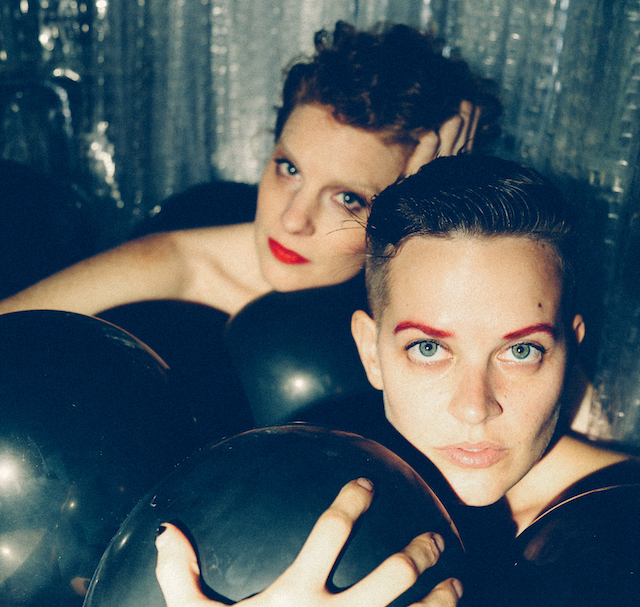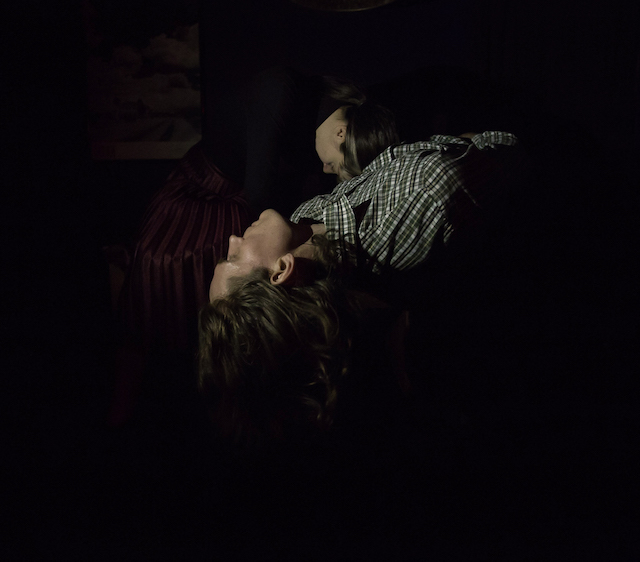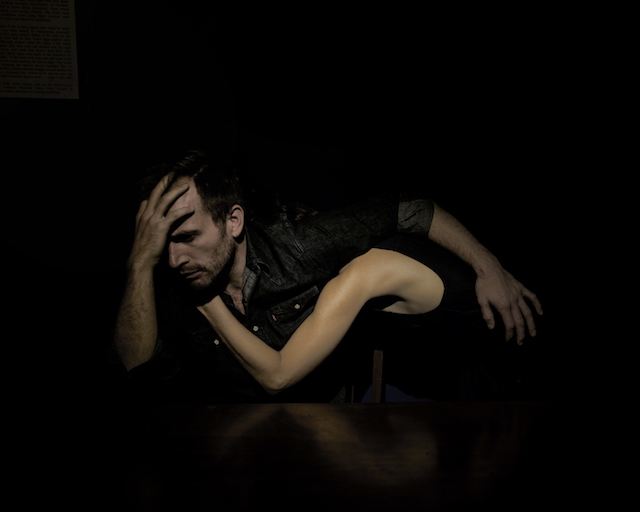feature image of Kelly Bartnik and Tori Sparks by Elizabeth Romanski
This past Sunday, I approached the cozy corner cafe in the Bowery where I was instructed to show up at 5:30 PM with my email confirmation in hand. I didn’t know exactly when or where the performance would start or how long it would last or really what to expect at all. I was supposed to arrive here on time. Someone would find me and usher me to where I needed to be. That’s all I knew and I was anxious to begin.
A couple weeks prior, Kelly Bartnik invited me to the preview of her new long-term immersive play, HERE. Bartnik is best known as a performer in Punchdrunk’s immersive production, Sleep No More, where she originated the role of Bald Witch in both the Boston and NYC productions.

Immersive theater is a highly experimental genre of theatrical experiences that break down the fourth wall, blurring the lines between watching, participating in, and experiencing live performance. U.K.-based Punchdrunk’s Sleep No More was the first large-scale immersive performance in the U.S. when it opened in Boston in 2009. Sleep No More continues to sell-out in its current home in New York City, where it’s been running since 2011.
Bartnik met her girlfriend, Tori Sparks, at Sleep No More, where they were both original cast members. After experiencing HERE, I had the opportunity to chat with Bartnik about her craft, her thoughts on performing in and creating immersive work, and her four-year relationship with Sparks. Sparks is the art director for HERE. It’s the first time the couple have engaged in creating work together, though they worked together as performers for years.

Bartnik says it’s fitting that they came together as a couple since they played the strongest female characters in Sleep No More, Lady Macbeth (Sparks) and Bald Witch (Bartnik). “We compliment each other,” Bartnik said, “We’re both alpha females.”
For HERE, Sparks strong design choices help create the feeling of being transported to another reality. At one point, I found myself surprised by lush green ivy creeping across the vintage wallpaper in a narrow room, spreading down into a wall of picture frames like what you might find in your childhood home. The ivy emphasized the passage of time in that space, the unreliable dull edge of reality and memory. It was both comforting and disturbing in its surrealism, as nostalgia for our childhood often is.
HERE is an independent production conceived by Bartnik in what she calls a highly collaborative process. The cast and crew are comprised of immersive theater forerunners. It was collectively written by Bartnik and the cast: Donna Costello, Jeff Lyons, Zach Martens, and Tori Sparks. The all-female production team includes Bartnik and Yvonne Chang, Jae Lee, Lisa Leighton, and Tori Sparks. “Most other immersive shows out there right now are produced primarily by men or focused on men,” said Bartnik. This is the first immersive show she has conceived and directed.
The concept of HERE is to stretch the immersive form into a long-term work that will run in episodic format, allowing audiences to witness the story unfold over time. Similar in structure to a television series, HERE invites audience members into the live performance of each new episode which builds on the previously crafted narrative. The ever-expanding storyline allows for new character introduction and the continuation of existing characters’ trajectories over time.

Bartnik said HERE was inspired by TV family dramas like Six Feet Under and Friday Night Lights, as well as serial TV shows that are available in full season releases on Netflix and Amazon. “I’m interested in material that’s easily relatable,” she said, “and in the connection between theatricality and reality and blurring those lines.”
The best moments in immersive theater, Bartnik explained, are the moments when there is a “crossing over from performer to person,” the moments of connection between the audience and the performers that are in some way genuine and earnest, even though the show is choreographed and scripted. “Sometimes,” Bartnik explained, “you’re exhausted or having a hard day and the emotions of sadness or anger in your performance are things you’re really experiencing. You have to be present [with the audience members] in immersive theatre. You can’t just phone it in.”
If one purpose of HERE is to facilitate intimate moments between performers and the audience, it succeeds. The pilot episode is limited to just five audience members per night, with a cast of three performers. Walking through the rooms and memories of a childhood home, the characters use monologue, physical contemporary dance, and storytelling to connect with the audience, at times performing for and interacting with just one audience member in solitude.

On Sunday, the first day of previews, I entered the cafe at the address emailed to me. I must have looked lost because a woman came right up to me and asked if I was there for HERE. (The cafe serves as front-of-house for the show because the performance itself is in a small unconventional space.) I sat down in the reserved area of the cafe, ordered my complimentary drink, and took notice of a funeral card for a person I didn’t know placed at my seat.
When all five audience members had arrived, the host notified us it was time to go and took us to the performance space, which was behind a nondescript door with no signage or indication of what was behind it. We descended a staircase down to a dark landing and from that moment, the show had begun, before we even realized it was happening. We emerged through that same door less than an hour later, shaken and a bit disoriented and eager for more. (Like a good TV pilot, the first episode ends on a cliffhanger.)
I left feeling exactly how you feel when your favorite show drops a new episode—anxious and hyped up and wanting to over-process it. It was jarring coming back out onto a NYC street, after being transported to another reality just down a staircase. My fellow audience members (all of whom, coincidentally, were queer women) and I spent a few minutes discussing our different experiences in the show. We realized we all saw different pieces of the same story and started putting the narrative together collectively. We ended up going down the street to grab a drink because we wanted to talk more.
As soon as the first episode opens officially, work will begin on the second episode. The next episode may be at a different location, have a different format, introduce new characters, etc. “Maybe next time it will be in a high school gymnasium with two actors and 500 audience members,” said Bartnik, “…or maybe the next two episodes will be at a different location and then the fourth will be back at this one.” The open format of immersive theater is part of what appeals to Bartnik. Like a TV show, the episodes will be written and created in real time, similar to how a “writers’ room” creates episodes of a serial TV show. There’s no set ending to this story or set narrative for these characters, nor is there a set end date for the production.
HERE is a mash-up of live theater and episodic television drama in the best way. The production value of this show is high and far beyond what you might expect for off off Broadway. The actors are superb and experienced with immersive performance. The set design and art direction for the pilot episode is beautiful and works in tandem with the incredible sound design (by John Glover) and direction.
There was a moment, for example, when a character was telling me about a memory of hearing china breaking and, as he was saying it, I thought I heard glass shattering in the distance. It turns out, after discussing it with another audience member, that the character she was with was breaking china at the precise same time in another room.
HERE manages to be both experimental and accessible. Anyone would enjoy the performance and be able to relate to the very human stories that drive the narrative, even if you’ve never experienced immersive theater before. Queer audience members will surely connect with these characters, with the discord between past and present identities, the complicated relationships we have with our hometowns and childhood friends, how we negotiate surviving trauma and being present.
The pilot episode of HERE is in previews this week, running through Sunday, February 26th. Tickets are $75 and are available at the HERE website. Hurry if you want to see it; the shows are selling out fast! Look for the official opening of the pilot episode of HERE this spring.
Pilot Episode (via HERE website): With the news of the death of a long-absent father, two siblings and their childhood neighbors find themselves returning to the place they once called home. As they singularly descend on the location of their last physical connection, the four of them find themselves jolted into a layered whirlwind of memory and sensation where they must not only come to terms with their connected pasts, but with the paralleled and unexpected reality of the present.







